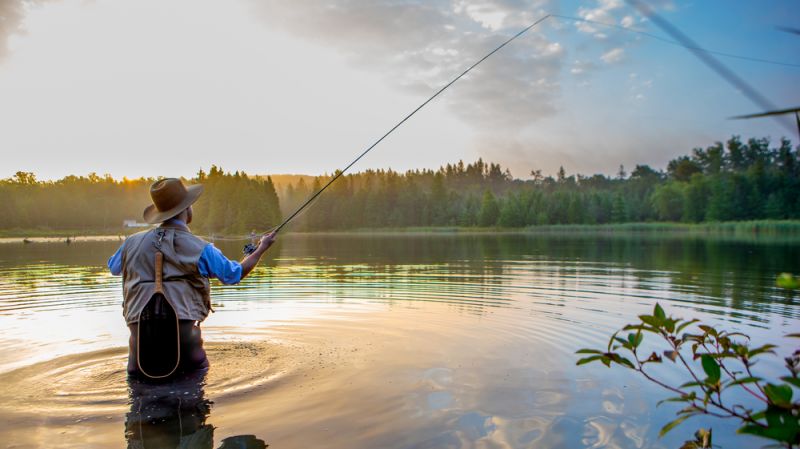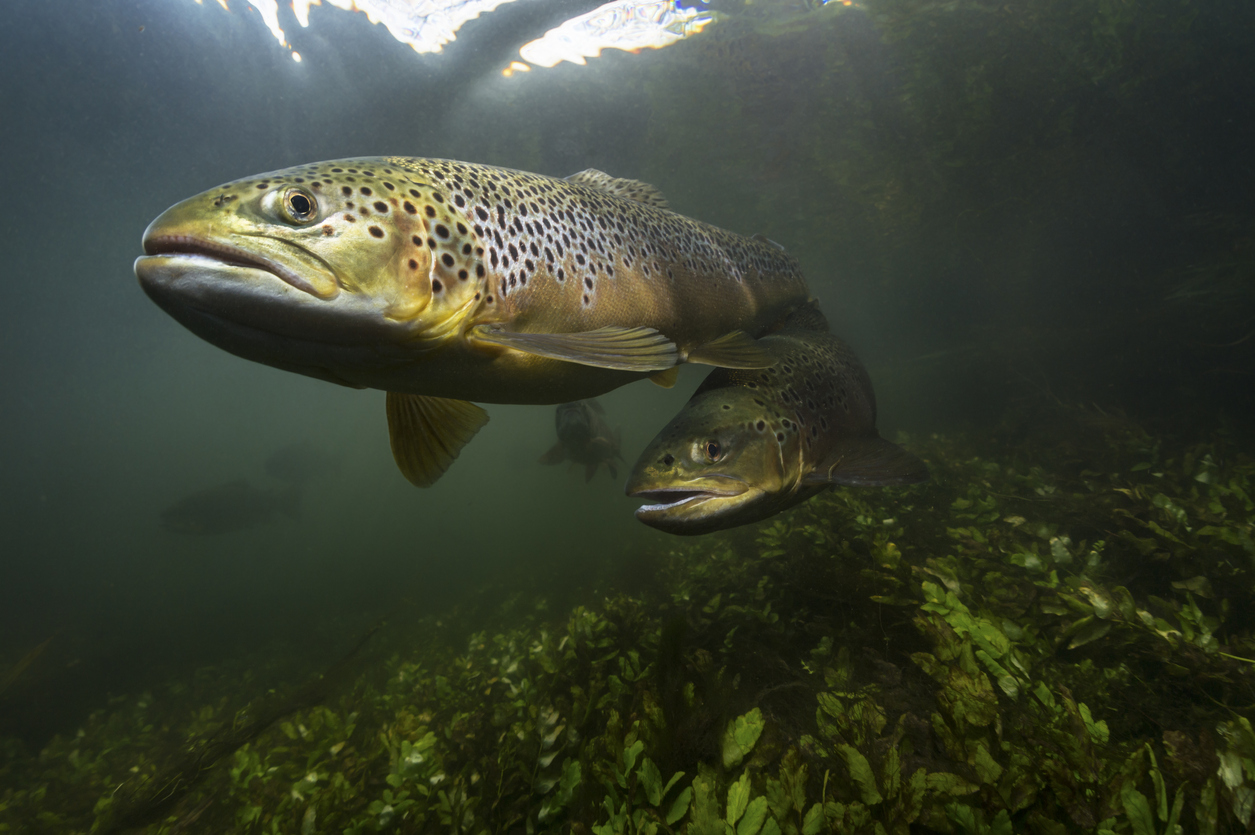A Marketer’s Meditation on Fly Fishing
What can a beloved summer pastime tell us about sustainably enjoying the natural world?

As the lazy days of summer settle in, Annetta Grant, MSc'12, PhD'17, wants you to consider the contemplative yet paradoxical pursuit of fly fishing. A fly fisher herself, Grant understands the rhythms of wading into gently flowing streams, noting the insects and plants skimming the surface of the water, casting a handmade fly carefully designed to mimic a fish’s favourite food, feeling the tension in the line as the fish takes to the fly and struggles to set itself free.
Grant now invites you to view this fly fishing tableau through the lens of marketing. Here is the fly fisher as the consumer of a natural world encounter, as someone who invests considerable time and money into catching salmon, trout or other sport fish only to release them back into the wild. What can fly fishing teach us about the sustainable consumption of a precious resource?
We know a lot about consumers in the marketplace but not nearly as much about consumers in nature, says Grant, an assistant professor of markets, innovation and design at Bucknell University in Pennsylvania who holds a PhD from Smith School of Business. There is the material factor: an avid fly fisher can spend more than $1,500 a year on the sport. But that’s only part of the story. What about the transaction between consumer and nature, between angler and fish? In what ways are both transformed?
Grant spent considerable time trying to answer those questions — perhaps starting all the way back to her youth fishing in the great salmon runs of the Gaspé region in Quebec. “As a consumer researcher, I’m deeply curious about questions not only about consumption but especially now, in the face of climate change and biodiversity loss, how consumption impacts that,” she says. “How can consumer researchers start thinking differently about our relationships with nature?”
Take me to the river
There was only one way to answer such questions: go to the source. Enlisting the help of Robin Canniford (University of Galway) and Avi Shankar (University of Bath), Grant conducted ethnographic interviews with a variety of fly fishers to understand how they experienced the sport and whether their views evolved over time. She accompanied many of them in the field and filmed them in action with a GoPro. “After fishing, we’d sit down and use that video as a way to ask questions about what was happening in those moments,” says Grant. “How did they feel about the experience?”
While she couldn’t interview the salmon or trout for their views, Grant consulted a fish biologist and aquatic science texts to better understand fish biology and behaviour.
It took some time for Grant and her fellow researchers to make sense of the hours of videography and pages of notes, but what emerged was something like a three-stage journey map for the nature-based consumer, and the consumed.
The first leg of the journey is like a blissful unawareness of the other: the angler-to-be enjoying rejuvenating time on the water, the sport fish slicing through streams in search of food or preparing to spawn. Grant calls this a “separated encounter”; for some river visitors, it can trigger curiosity and a desire for a more hands-on experience.
Now motivated to learn more, inexperienced anglers read up on the fine points of the sport: how to select flies, the best casting techniques, how to interpret environmental conditions such as the presence of aquatic insects, dimples in the water, sunken trees and rocks and more. Importantly, they learn how to approach wild species on their own terms.
“They start to recognize all these interconnections between species, and that allows them to more deeply understand what’s happening in the natural environment,” says Grant. “A cognitive transformation starts to happen. And they begin to move their bodies in a different way too, hunching over as they start to look at the water differently.”
These “slippery encounters” between the budding angler and fish, as Grant terms them, are ephemeral — they can easily be cut short by a falling branch or malfunctioning equipment.
Even in these slippery encounters, the fish are transformed. They are now prey and behave accordingly. “In contrast to popular portrayals of fish having four-second memories,” says Grant, “salmon and trout learn from encounters with humans. They apply their own senses to detect changes in barometric pressure or chemical cues, and they become wary of fishing gear.”

Sticky encounters
Finally, in the “sticky encounter”, angler and fish come into direct contact through rod, reel, line and hook. Grant says these moments of close contact, when the hooked fish begins to fight, reveal both the imbalance of power as well as the potential for transformation.
Not much good comes of it for the salmon or trout — they are transformed into objects of amusement and, if they escape with their lives, are left injured or traumatized.
But for fly fishers, coming face to face with the live animal can trigger empathy and the desire to protect the natural world, says Grant.
“Those moments of close contact, when people hold that fish in their hands, cause them to pause and reflect upon the life of the fish. It makes them see the fish in a new light and in some instances can provoke a moral awakening.”
This sticky encounter has the potential to transform the angler from hunter to steward. In her research and observations, Grant says many fly fishers who have awakened to their environmental impact shift their practices. Beyond catching and releasing, which is already part of the fly fisher ethos, they may use barbless hooks so fish can be released more easily. They may eschew hooks entirely, which removes any chance of snagging a fish, as one participant in her study now does. They may also join campaigns to protect riparian environments as healthy habitats for salmon, trout and other sport fish.

Dark side of fly fishing
Yet there remains an inherent paradox to fly fishing that is hard to overlook. For one, much of the conservation efforts of fly fishers are designed to ensure resources are there so they can continue harassing fish, sometimes violently, for their own amusement. Tellingly, none of the fly fishers who participated in Grant’s study have given up the sport.
Conservation efforts are also selective, aimed at charismatic species that are useful to recreational consumers. Grant offers the example of the brown trout that was translocated by British aristocrats from English and Scottish rivers to Canada and other colonies. This prized fish has been amazingly resilient in adapting to a new habitat yet is also the definition of an invasive species, preying on native fauna, outcompeting indigenous fish and transmitting disease. Still, it remains a protected species in many jurisdictions in North America. Like our canine companions, brown trout seem to have figured out how to flip the power dynamics and get humans to protect their interests.
Grant can acknowledge these darker sides of fly fishing and still see the power of natural-world encounters to shift thinking in positive ways. Many of the anglers she interviewed reported a deeper awareness and respect for the interconnections in river environments, a web that is hard for us humans to understand.
As her fly fishing research shows, it is possible to see the consumption of natural world encounters as a way to get more “consumers” to appreciate the fragility of nature and lessen their own impact on species and natural habitats.
“Through those three types of nature experiences,” says Grant, “our study shows how people can develop more sustainably-oriented practices.”